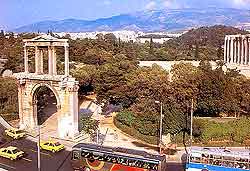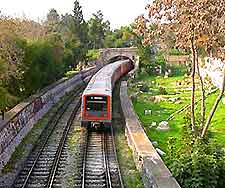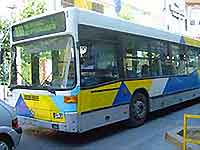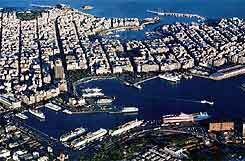Getting Around, Athens Travel, Transport and Car Rental
(Athens, Attica, Greece)

There is no denying that the Greek capital can be a little chaotic and confusing to find your way around at the best of times, particularly when traffic and public transport is at its busiest. However, with a little pre-planning and organisation, your Athens travel plans need not be overly daunting, with added confidence often being provided by a pocket map.
Parts of central Athens are particularly walkable and this provides an excellent way to sightsee, especially around the Acropolis area. Many sections of the city centre are now entirely free of traffic, with expansive pedestrianised areas. Elsewhere, using the local bus transport to travel to your chosen attraction may be your most convenient option, although do first consider the modern network of metro trains.
There are also three popular tram lines available in central Athens, connecting the city centre with the coastline and also the Peace and Friendship Stadium (Stadio Eirinis kai Filias) in the neighbouring seaside suburb of Faliro, Piraeus, roughly 8 km / 5 miles to the south-west.
Athens Eleftherios Venizelos International Airport (ATH) / Arriving by Air
The city is served by one of Greece's busiest airports, the ever-popular
Athens Eleftherios Venizelos International Airport (ATH).
Athens Eleftherios Venizelos Airport (ATH) Guide
Car Rental
Driving a car in the centre can be confusing and Greek tempers are often short where inexperienced drivers are concerned. Cars cannot travel in certain parts of the city, such as around the major squares, and therefore driving around is not always as easy as it might first appear. However, cars are ideal when travelling outside of Athens on excursions and provide a good method of transport for day trips. The busy ring road, the Attiki Odos (a toll motorway), circles the entire city and connects the Olympic Stadium with both the city and Athens Airport.

Metro
In March 2000, the city proudly launched its Metro system, ready for the 2004 Olympic Games. With three lines, run by the Athens Urban Transport Organisation, the Metro provides a quick, easy and inexpensive way to travel around the city. Line 1 heads south-west to north-east, with the final stop being the port of Piraeus. Line 2 is the shortest line and starts slightly south of the city centre, running to Sepolia. Line 3 begins at Syntagma Square and terminates at Athens Airport.
Taxis
Taxis in Greece, especially in Athens, are unlike taxis in other countries. They are often shared if passengers are travelling in the same direction and it is not unusual for taxi drivers to turn you down if they do not wish to travel to your intended destination. Actually getting a taxi in Athens can be difficult at certain times of the day - particularly if you wish to travel after lunch.
Always make sure that the meter is on when you start out and not set to '2', which is the double fare that is only permitted late at night. Taxis in the Greek capital are very cheap and many people travel in these cabs, treating them almost like minibuses. There are some radio taxi firms that can be booked by telephone, although these are often more expensive.

Buses
The buses in Athens serve the city centre and main tourist districts, running day and night, 24 hours. Blue buses connect the city centre to its outer suburbs, offering a highly convenient method of travel. At peak hours, this bus service can become crowded and it may therefore be easier to use another mode of transport at that time.
By Foot
The city centre was extensively pedestrianised for the 2004 Athens Olympic Games and provides easy access for those visitors simply wishing to walk around.
Trains
Greece is served by a good railway network and trains travelling to destinations in Northern Greece and Europe depart from the city's principal station, Larissis. The other station in Athens is the Pelopónnisos station, where trains regularly head off to Peloponnese. Both of these railway stations are situated in the city centre. Of note, the train network is run by the Hellenic Railways Organisation and much of the service is restricted to domestic destinations.

Boats and Ferries
Unless you require a berth or first class seat, it is not usually necessary to book your ferry travel in advance. Simply arrive at Piraeus port a couple of hours before departure, where ferries and hydrofoils leave for all the Greek islands. Advanced ferry schedules are listed in the 'Greek Travel Pages', available at main bookstores. There are also some boats that travel to international destinations, such as
Italy,
Cyprus and even
Egypt.
 There is no denying that the Greek capital can be a little chaotic and confusing to find your way around at the best of times, particularly when traffic and public transport is at its busiest. However, with a little pre-planning and organisation, your Athens travel plans need not be overly daunting, with added confidence often being provided by a pocket map.
There is no denying that the Greek capital can be a little chaotic and confusing to find your way around at the best of times, particularly when traffic and public transport is at its busiest. However, with a little pre-planning and organisation, your Athens travel plans need not be overly daunting, with added confidence often being provided by a pocket map.


